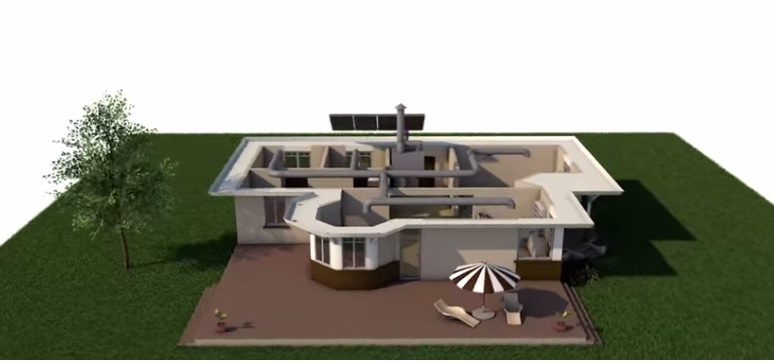Our solar cooling system is a low emissions alternative to conventional air conditioning and gas or electric powered heating, providing more comfortable homes, reduced energy bills and a cooler planet.
Over 50 per cent of the greenhouse gas emissions you produce in your home are generated by heating, air-conditioning and hot water.
A screenshot from the video (below), which explains solar cooling.
In other words keeping your home warm in winter, cool in summer with nice hot water on tap is emitting 2.5 to 5 tonnes of greenhouse gas emissions each year.
It also contributes a hefty amount to your electricity bill, between 50 to 60 per cent.
CSIRO has invented a new solar air-conditioning system for Australian homes. This technology solution will reduce Australia’s emissions, reduce your energy bills and reduce our demand for electricity and gas.
It is an innovative three-in-one technology that provides hot water, cooling and heating.
It works by using heat from the sun and employs both desiccant and evaporative cooling technologies.
Solar heat is first collected and stored as hot water, which can be used directly in the house. A portion of the hot water is diverted into the solar air-conditioning unit, which is used to either heat or cool the air coming into the building.
Emissions and electricity
Our solar air-conditioning system uses only a fraction of the electricity of current air-conditioning systems and halves greenhouse gas emissions.
We have calculated that if every home in Australia installed our solar cooling technology it would be the equivalent of saving 15 mega tonnes of CO2 or taking 3.5 million cars off the road.
Peak demand is a major issue facing energy suppliers and air-conditioning plays a strong role in generating peak demand. It is perhaps surprising to know that every $1500 air-conditioner installed imposes $7000 in costs on the energy system1.
Solar cooling air-conditioning systems are likely to be an important component of future zero emission buildings and can help reduce peak demand on the electricity grid.
The video explains how solar air-conditioning works or you.
Fast facts
- In Australia electricity usage nearly double on the hottest days due to increased demand for air conditioning.
- Solar cooling uses natural heat from the sun and so consumes much less electricity than conventional cooling systems.
- Solar cooling air-conditioning systems are likely to be an important component of future zero emission buildings and can help reduce peak demand on the electricity grid.
Extra facts
- Keeping your home warm in winter, cool in summer with nice hot water on tap is emitting 2.5 to 5 tonnes of greenhouse gas emissions each year.We have calculated that if every home in Australia installed our solar cooling technology it would be the equivalent of saving 15 mega tonnes of CO2 or taking 3.5 million cars off the road.
- Solar cooling technology is not new. In 1878, Augustin Mouchot amazed audiences and won a gold medal at Universal Exhibition in Paris for his invention which used the sun’s thermal energy to produce a block of ice.



10th April 2020 at 8:24 am
It would be wonderful to get more information, where this form of heating, water and airconditioning is available. Could you please send me information?
16th April 2020 at 11:53 am
Hi there! Thanks for your message.
We recommend households conduct their own research into electricity systems and retailers.
For more information on our Energy research, please visit this link: https://www.csiro.au/en/Research/EF
Kind regards,
Kashmi
Team CSIRO